There are quite a few options for knitted slippers: with a seam and seamless, knitted on 2, 5 or circular needles. Some with diagrams and descriptions are presented below. Work begins with choosing the right tools and material.
Yarn
The appearance and comfort of knitted slippers depends on the yarn. When choosing threads for knitting, you need to pay attention to the composition (this should be pure wool or semi-wool thread) and the thickness of the thread (it is better to choose threads of medium thickness, where for 100 g of thread weight the length is no more than 300 m).

When knitting slippers for children, special children's yarn is selected: soft, hypoallergenic, with a safe composition. The color of the yarn is selected individually. It is important to remember that if yarn of different colors is used, it must have the same texture and thickness.
Spokes
To knit slippers on 5 knitting needles, you need to purchase a special set of knitting needles, called stocking needles. They can be metal, wood or plastic.

Knitting needles also differ in diameter, which is identified by the marking. For knitting slippers, the size of the knitting needles is selected in accordance with the thickness of the yarn. If yarn of 250-300 m/100 g is selected, then knitting needles No. 2.5 or No. 3 will do.
Simple slippers with knitting needles for beginners
It is convenient to knit slippers with knitting needles, having information with diagrams and descriptions in front of you. The size of the proposed slippers is from 36 to 40. You will need two knitting needles No. 4 and the corresponding threads. The required number of loops for the base is 34.
For winter, wool yarn is used; for summer slippers, cotton yarn is suitable.
Each row begins and ends with edge stitches:
- Row 1: knit entirely with front stitches.
- 2nd row: alternate 10 knit stitches and 1 purl stitch.
- This is how 34 rows are knitted.
- Row 35: 11 persons, then an increase by knitting 2 loops from one, then 8 persons, again an increase and 11 persons. Increases are made for the widening area of the foot.
- Row 36: 10 knits, 1 purl, 12 knits, then knit in mirror image.
- Row 37 is knitted.
- Rows 38–63 are similar to the previous two.
- From 64 to 72, alternating front and back loops.
- There is no need to close the loops. The thread can be cut, leaving a small end.
The result is a canvas. For assembly, the thread is pulled through the loops left open, pulled together and secured. Using a needle, the part knitted with an elastic band is sewn together + several rows (the depth of the foot prints will depend on this).
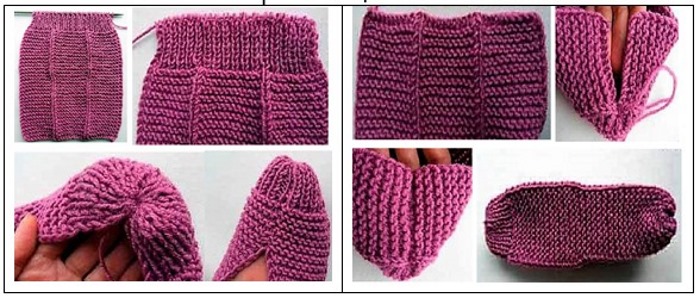
The heel is assembled: a thread is pulled through the loops of the middle part of the knitting, and the middle part is pulled together. The side parts are sewn together with a needle. Slippers can be decorated with embroidery and beads.
Children's slippers knitted
Knitted slippers with knitting needles with patterns and descriptions for children are also presented in large quantities. They can be knitted in a couple of hours. The proposed version of children's slippers is fixed on the leg with a lace that is threaded into the drawstring. It will suit a child whose foot length is 11 cm.
For knitting you will need Pekhorka children's yarn (200 m/50 g) and 2 knitting needles No. 2. When knitting, stocking stitch is used. The 1st loop at the beginning of each row is removed.
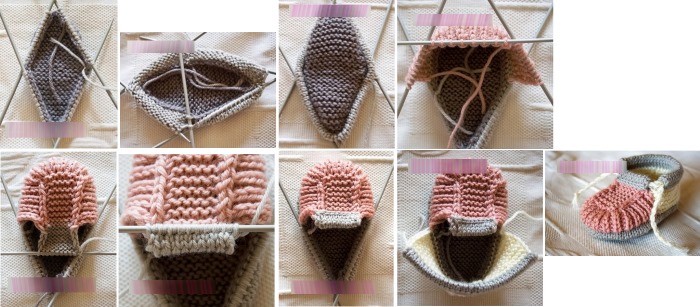
Knitting sequence:
- Cast on 18 stitches onto the knitting needles.
- 4 rows are knitted according to the pattern.
- Row 5: after the slipped loop, yarn over, knit 2 loops together, the last one according to the pattern. You have a fold line.
- Rows 6-10 are knitted in stocking stitch.
- Row 11: fold the knitted fabric along the line of teeth and knit the 2 edges together. The drawstring is ready.
- Row 12: knit according to pattern.
- To knit the heel, the 1st loop must be removed, 16 are knitted, the last one remains unknitted. Knitting is turned.
- The first loop is removed, 15 are knitted purlwise, the last one remains unknitted. Knitting is turned.
- In the next 2 rows, 2 loops remain unknitted, then in the next two 3, then 4, 5, 6.
- Then the number of loops increases. In the 27th row, 6 front loops are knitted, the knitting is turned.
- In rows 28 to 38, the number of working loops increases by one in each.
- From rows 39 to 52 there is stocking stitch (14 rows).
- From rows 53 to 76, rows 15 to 38 are repeated: the toe is knitted.
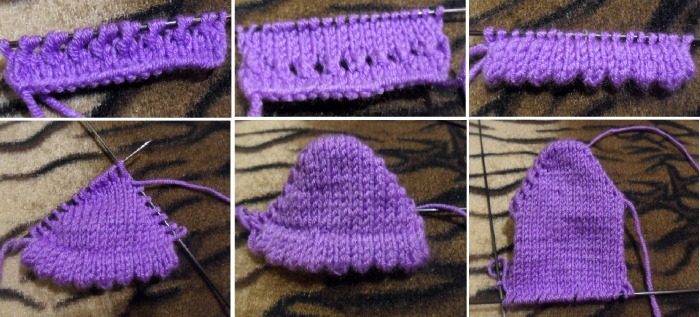
- Next, the upper part of the slipper is knitted.
- From row 77, the upper part of the slipper is tied to the lower part. At the beginning of each row, the right knitting needle picks up the loop of the lower edge and removes the first one, then knit 17 loops with the front ones. Knitting is turned around.
- All subsequent rows (up to 90) are knitted as follows: the loop of the lower edge is picked up, the 1st loop from the left knitting needle is removed to the right one, then 16 loops are knitted according to the pattern, the last 2 are knitted together.
- From rows 91 to 100, knit a drawstring, repeating the first rows (description is at the beginning).
- In the 101st row, knitting is closed by knitting together the first 2 loops and returning the knitted loop to the left knitting needle in order to knit it together again with the next one.
- The thread is secured and cut off, leaving a small end for sewing on the drawstring.
- You can use a satin ribbon as a cord, or use a crochet hook to tie a braid about 40 cm long and thread it through the drawstring.
Star's Footprints
These are seamless socks. They are knitted with knitting needles No. 3 (you need 4 pieces) from semi-woolen yarn. To knit size 37 socks, you need to cast on 42 loops on the knitting needles.
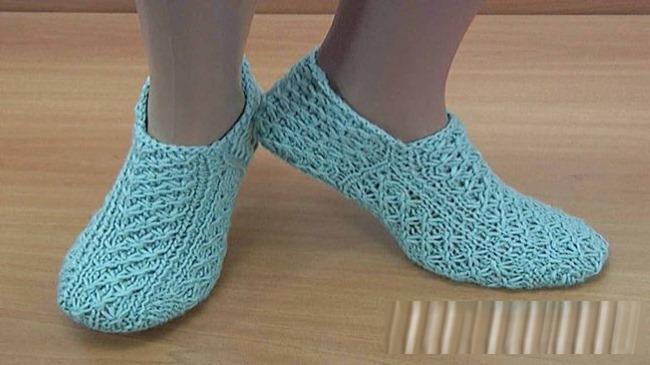
Knitting begins with the bar (front part), the first 10 rows are knitted with garter stitch. The length of the front bar is three quarters of the length of the foot, approximately 8 cm. Next, the toe is knitted. To do this, all the loops are divided into 3 parts, which results in 14 loops. Only 4 rows of the middle part are knitted with stocking stitch.
The first 14 loops are knitted, then the middle 14 and the work is turned. The side loops are transferred to pins. On the front side, the "Stars" pattern is knitted in a checkerboard pattern. The row begins and ends with an edge loop. To get a star, 3 loops are knitted together, a yarn over, and together again.
In the pattern rapport:
- 1st row: 3 knits, 3 of 3, 3 knits, 3 of 3.
- 3rd row: 3 of three, 3 knits, 3 of three, 3 knits.
- From the 5th row everything is repeated.
- The width of the toe is equal to a quarter of the length of the foot, i.e. 6 cm. The length of the toe should be equal to half the length of the foot, for this it is necessary to knit 36 rows, i.e. 12 cm. Then the loops from the pins are returned to the knitting needles.
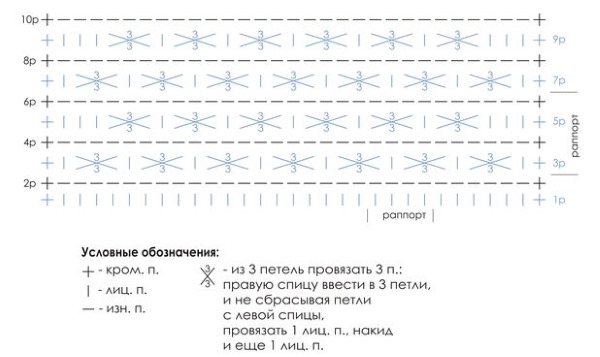
The side parts are knitted. The strap loops (14) are knitted. You will also need a knitting needle, onto which you need to cast on 20 side loops from the braid from the edge loops of the toe and knit them. Then knit 14 loops of the toe. And another 20 loops cast on from the other side and 14 loops of the strap. There will be 82 loops on the knitting needles.
The side part is knitted with garter stitch, it should be equal to a quarter of the foot length, this is 18 rows. The side part can be knitted with threads of a different color.
Knitting the sole
The sole can be double or with the addition of a special thread (for strength).
The sole is knitted like this:
- front rows: the 1st loop should be removed, the thread remains behind the work, then the next loop and the 1st loop from the side knitting needle are knitted together;
- purl rows: 1st is removed (the thread remains in front of the work), then you should knit together the next loop and the 1st loop from the side knitting needle.
Continue in this manner until only 14 middle loops remain.
Knitting the heel
You need to cast on 14 stitches from each of the edge stitch braids, which are distributed over 2 knitting needles. There will be 14 stitches on the left and 28 stitches on the right. You need to attach the side stitches.
To do this, 2 loops of adjacent parts (both in the front and back rows) are knitted together. Having knitted to the bar, you need to switch to garter stitch. Having knitted the back part of the bar, the loops are closed. It remains to secure the threads and the slippers are ready.
Slippers can be of one color, or you can use 3 different colors: for the strap, sole and upper part of the slipper. Knitted butterflies, also arranged in a checkerboard pattern, look beautiful.

Even rows are purl, the first and last loops are edge loops:
- 1st row: 2 knits, then 5 knits slipped (yarn in front of work), 5 knit stitches, 5 slipped, 2 knits. The first row is repeated from 3rd to 9th.
- Row 10: 4 purl, knit a “butterfly”, 9 purl, knit a “butterfly”, 4 purl.
- Rows 11 – 19 (odd): 7 knits, 5 slipped as described above, 7 knits.
- Row 20: 9 purl, “butterfly”, 9 purl.
Knitting a "butterfly": the right knitting needle is inserted behind 5 previously unknitted loops, picked up and transferred, knitting the next loop purlwise, the transferred loop is thrown over it. As a result, 1 loop is formed from two.
Knitted slippers with knitting needles with diagrams and descriptions have many options. The upper part of the slippers can be decorated with braids.

In the diagram, squares indicate front loops, circles indicate back loops:
 | The first and second loops are removed to the pin for knitting. First the third and fourth are knitted, then the loops from the pin. |
 | The same, only the loops are removed to a pin before knitting. |
How to knit men's socks
The proposed version of men's seamless socks:
- Cast on 36 stitches.
- Rows 1–6 are knitted in garter stitch.
- Rows 7–22: stocking stitch.
- From the 23rd row, knitting of the heel begins: 22 front loops, 23 and 24 are knitted together, the work is turned.
- Row 24: 12 purl, 13 and 14 knit together. Turn the work.
- Row 25: 12 knit, 13 and 14 together, work is turned.
- There should be 12 working loops left. 12 loops are cast on from the side braid, the knitting is turned around. The loops from the knitting needle are knitted. 12 loops are cast on from the braids on the other side, so the original number of loops is again in the work.
- 36 rows are knitted with stocking stitch. Then there are decreases.
- Front rows: 9 front, 3 together, 12 front, 3 together, 9 front. In the next odd row there will be 8 front loops on each side, 10 in the center, then 7 on each side, 8 in the center. The decrease is done up to eleven loops.
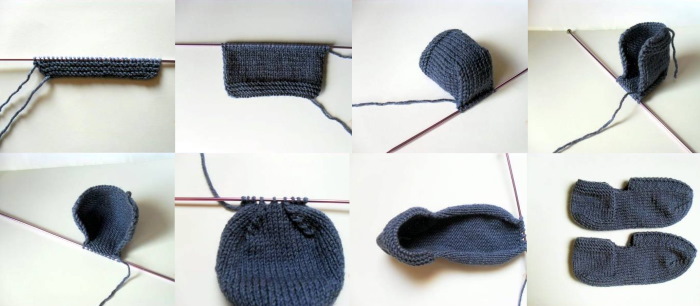
- Next, we begin knitting the front part.
- Turn the work over, knit the stitches on the knitting needle as purl stitches, the 12th row is knitted from a braid (knitting of all even rows is similar).
- In odd (front) rows: 5 front, 3 together, 4 front, knit the 5th from the braid.
- This is repeated until all the loops from the braids are knitted. The remaining 11 loops are closed.
Japanese footprints knitting
The slippers are knitted very quickly. The sides and sole are knitted with a 2 by 2 elastic band.
Step-by-step knitting pattern:
- For the right slipper, cast on 5 stitches and knit 2 rows.
- In odd rows, increases are made after the edge stitch at the beginning and before the last edge stitch. Such increases are made until there are 28 loops in the work. Even rows are also knitted with the front stitches. A triangle is obtained.
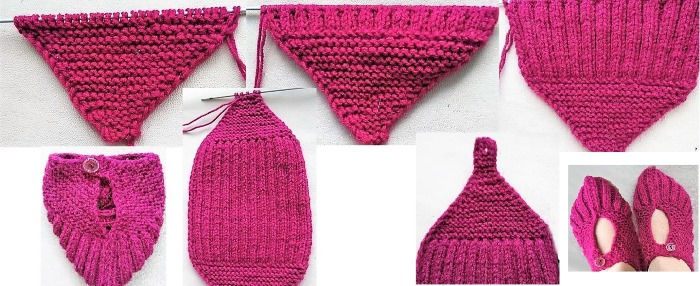
- Next, the number of loops doubles. The 1st loop is edge, the 2nd is front. Then, until the end of the row, 2 front loops are knitted from each loop: first behind the back wall, then behind the front wall. The last loop, before the edge loop, is knitted as a front loop.
- Continue knitting with a rib. The 2nd and penultimate loops in each row are knitted. Knit 15 cm.
- Next comes the garter stitch and decrease the loops by half, by knitting 2 loops together. In odd rows, 2 front loops are knitted together for the back walls (after the edge loop), at the end, 2 front loops are knitted together for the front walls (before the edge loop). There should be 5 loops left. They are used to knit the strap.
- Garter stitch is used for 5 rows. In the 6th row, a loop is made in the center using a yarn over. In the 7th row, the loops are closed.
- It remains to connect the halves. To do this, sew the sides.

The strap of the slipper for the left foot should be knitted on the other side. You can knit slippers not with a fastener, but with ties.
Rectangular slippers
The basis of the following slippers is a rectangle. They are knitted with garter stitch in one piece. You need to knit 2 identical pieces.
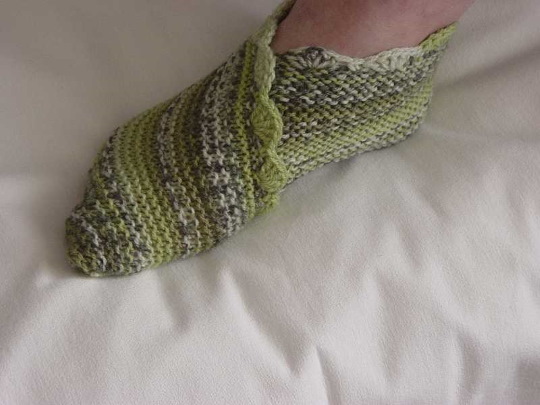

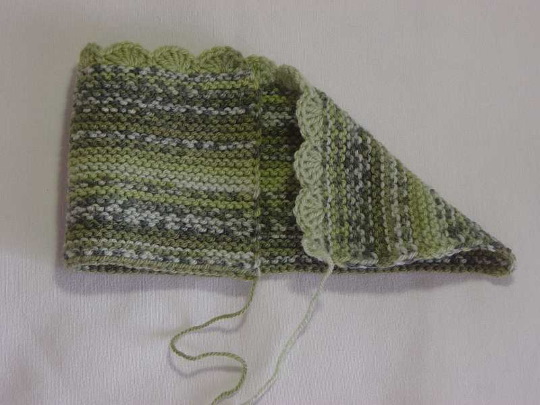
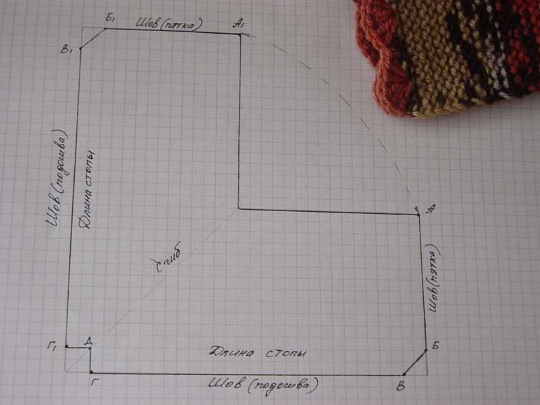
Scheme:
- For grey slippers, cast on 50 stitches.
- Knitted along the length of the foot, approximately 90 rows, then the loops are closed. It remains to tighten the loops of the sock and sew the seams of the heel.
- The fabric is folded in half with the front side down and the heel seam is sewn using the outer loops.
- On the opposite side, the fabric is divided into 3 parts and 2/3 on the right are pulled together using a thread, the ends of which are tied. The left part is placed on top and sewn.
This is for the right foot. For the left slipper, 2/3 of the left part is pulled together, and the right part is placed on top and sewn. For beauty, the slippers are crocheted.
Lazy jacquard
Knitted slippers with knitting needles (with diagrams and descriptions, you can make any pattern) usually from acrylic of different colors (one is preferably light). For work, take knitting needles that match the thread by diameter (circular ones are possible). Bulky yarn looks good.
When knitting with lazy jacquard, the color of the yarn changes after 2 rows.
First, knit the cuff using a classic elastic band. Using a dark thread, cast on 71 stitches and knit 5 rows.
Knitting the toe
The middle loop is selected (this will be the 36th). Increases are made in odd rows of any color. From the middle loop, 1 loop is added on each side. This is done by knitting them from the yarn over.
The middle loop is knitted with only one color. In other cases, it is removed, leaving the working thread in the front rows behind, and in the back rows in front of itself. After the cuff, the knitting of the lazy jacquard begins. A thread of a different color is included in the work.
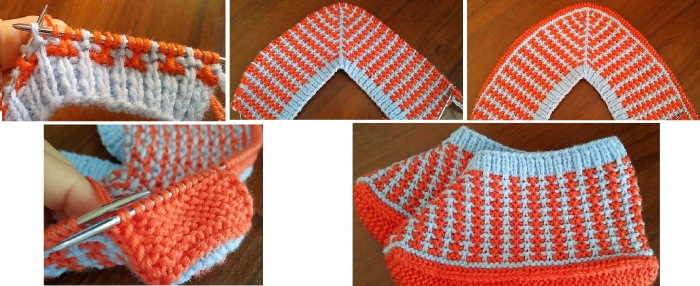
Knitting pattern:
- 1 row: 3 persons., 1 remove, this is to the middle loop. From it knit in the reverse order.
- Row 2: the removed loops are simply removed again, all other loops are knit. The thread is changed.
- Row 3: 1 knit, 1 slip, *3 knit, 1 slip. From the asterisk, repeat to the marked loop, on both sides of which you need to add a loop. And then knit in reverse order.
- Row 4 is similar to row 2. Loops added earlier are knitted.
- 38 rows are knitted by repeating from 1st to 4th. The side part is ready.
Knitting the sole
Knit 4 rows, alternating colors. Cut off the light thread, secure the end.
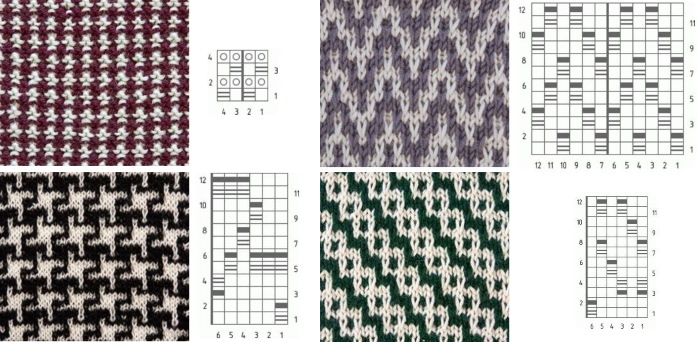
Scheme:
- In the next row, knit all the loops up to the marked one, + 5 more. One loop is removed from the left knitting needle, the 2nd is knitted, and the first one is thrown onto the second one on the left knitting needle. The work is turned over.
- Remove 1 st stitch, knit 11, purl 2 together.
- There should be 11 loops left in the center. From the wrong side, the outer loops should be knitted together with the next one. From the right side, 2 loops are knitted together, with a front loop and a draw through.
- Turn the work and remove the first loop. On the wrong side, the thread should remain in front of the work, and on the right side, behind it. Braids have formed on the sides of the sole.
- Continue knitting until there are 5 loops left on both sides.
- An additional decrease is added. On the sides, 2 loops are knitted together. The sole loops will decrease by 1 each row until 1 remains.
- The remaining loops are pulled together, cut and secured.
The slipper is sewn from the heel to the cuff along the back. The finished slippers correspond to sizes 38-40.
Slippers knitted by Olga Kolesnikova
Knitted slippers with knitting needles with diagrams and descriptions are presented in the author's master class. For their knitting, yarn of 2 colors is selected. The author has white and lilac. The upper part of the slipper is knitted on circular knitting needles and crocheted to a ready-made felt sole (which can be bought).
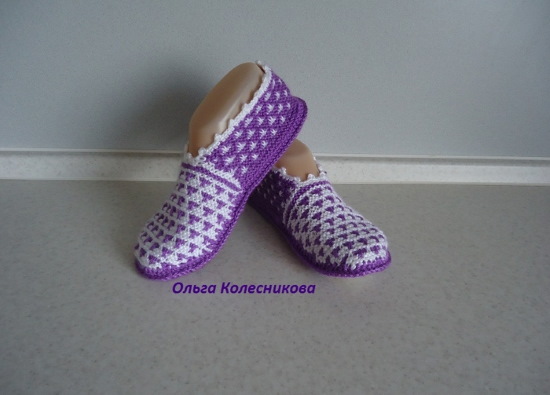
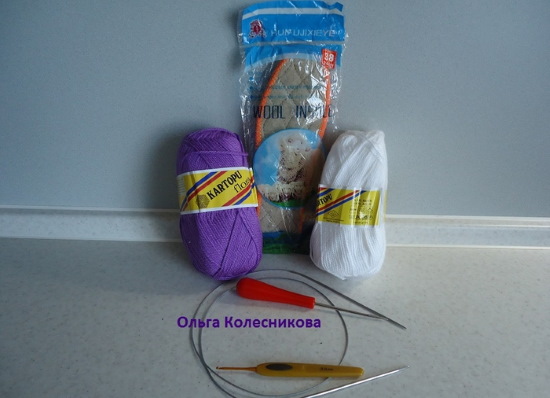
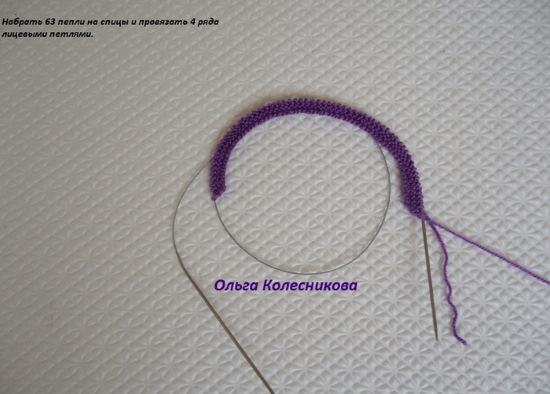
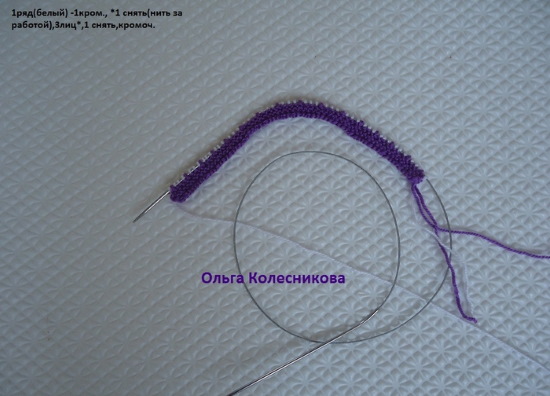
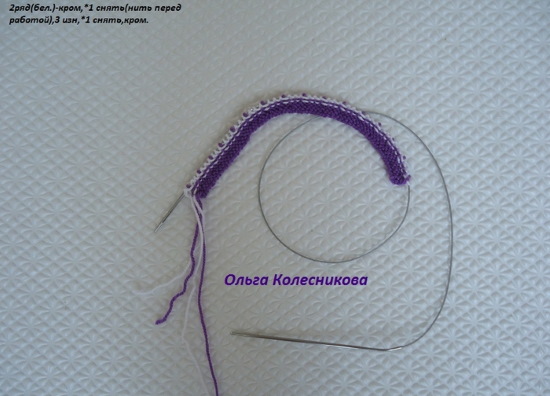
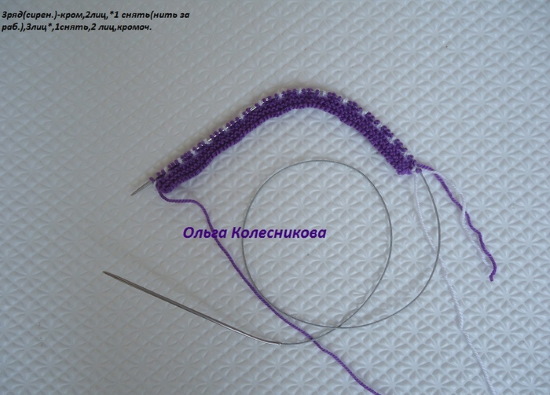
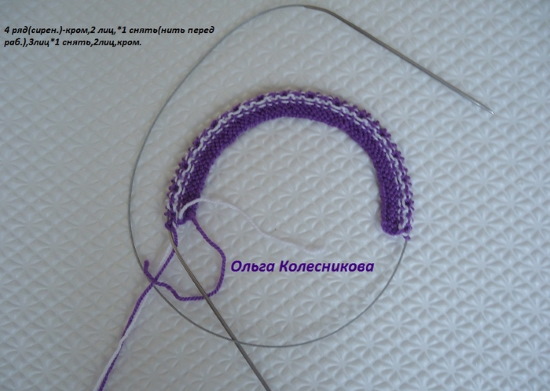
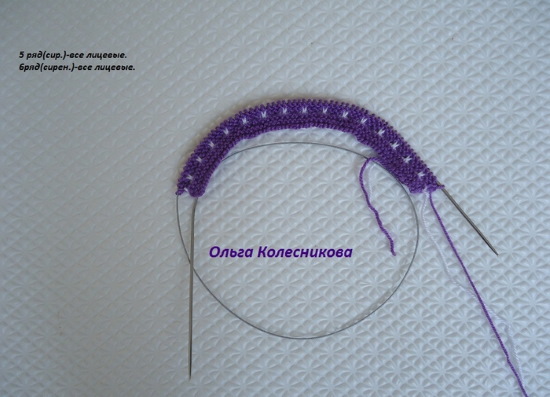


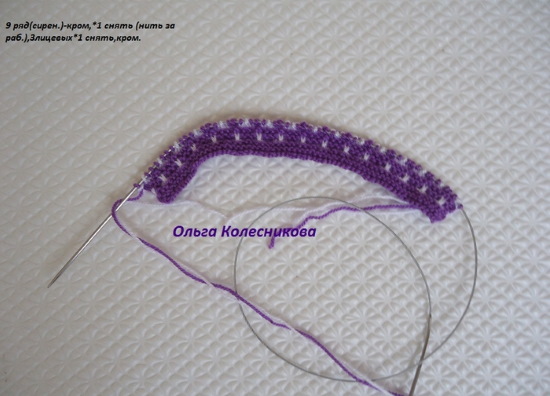
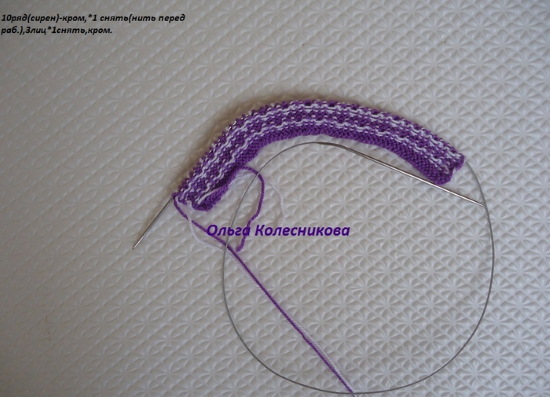
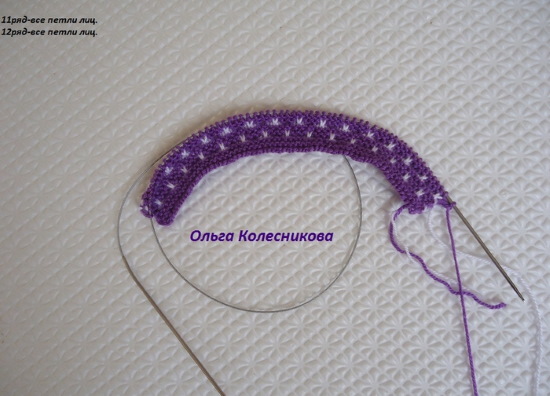
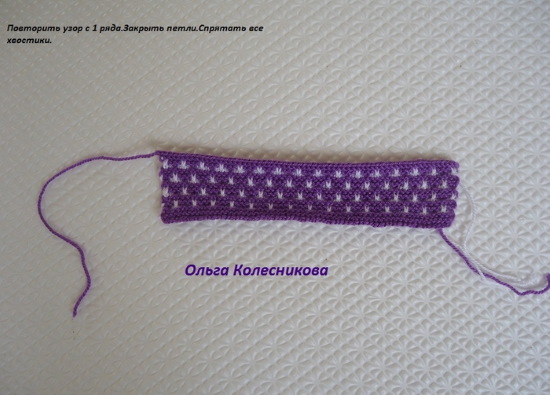

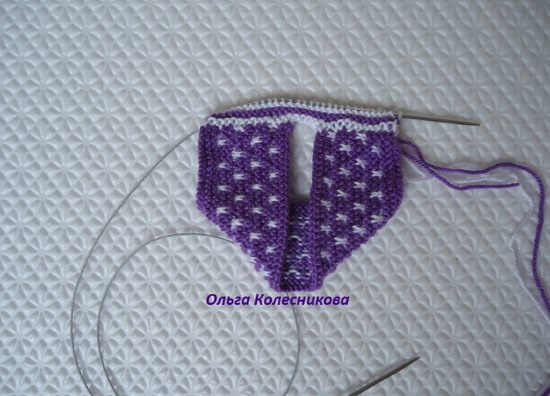
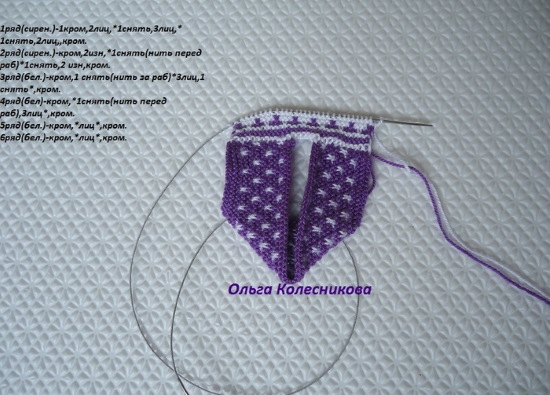
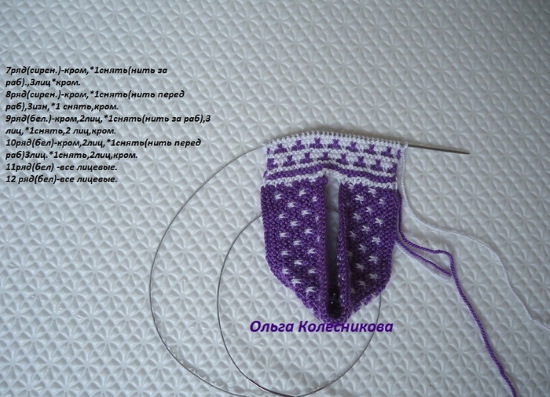

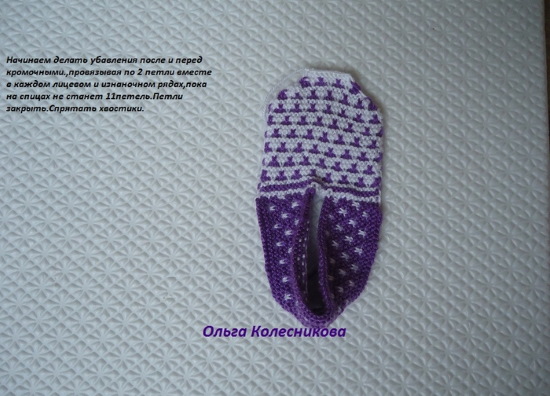
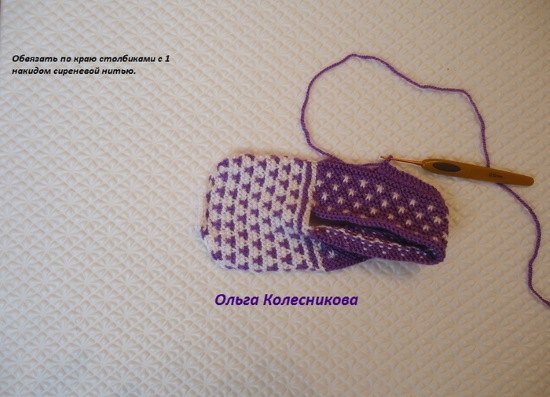
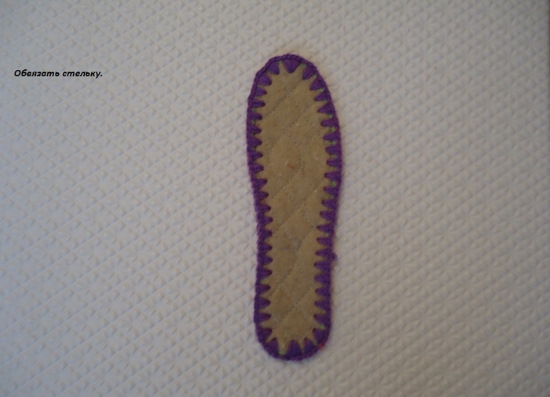
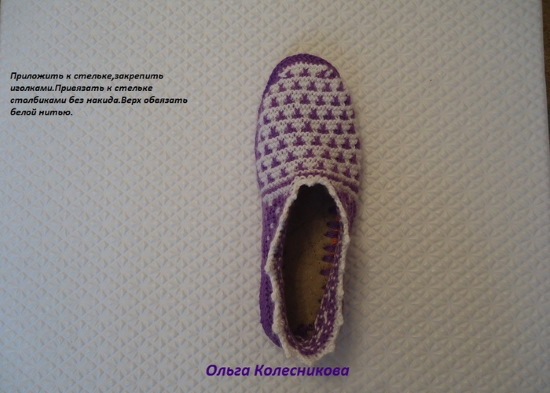

Knitting pattern:
- For knitting, 63 loops are cast on. 4 rows are knitted with lilac threads. Garter stitch is used. Proceed to the pattern.
- Rows 1, 2, 7 and 8 are knitted with white thread. Rows 3 through 6 and 9 through 12 are knitted with lilac.
- The fragments highlighted in yellow are repeated. Repeat this pattern twice.
Scheme 1
| 12 | + | + | ||||||||||
| + | + | 11 | ||||||||||
| 10 | Lilac thread | + | / | / | + | |||||||
| + | | | | | + | 9 | ||||||||
| 8 | + | — | — | / | — | — | — | / | — | — | + | |
| + | | | | | + | 7 | ||||||||
| 6 | + | + | ||||||||||
| + | + | 5 | ||||||||||
| 4 | + | / | / | + | ||||||||
| + | | | | | + | 3 | ||||||||
| 2 | White thread | + | / | — | — | — | / | + | ||||
| + | | | | | + | 1 | ||||||||
Legend:
- plus - edge;
- minus - back;
- empty square – front;
- vertical line – remove the loop, leaving the working thread behind the knitting;
- diagonal line - remove the loop, leaving the working thread before knitting.
After knitting the patterns, the loops are closed:
- Then, using white threads, loops are collected from the sides. 13 loops on each side and 5 more between them.
- Knit 1 row with knit stitches, then 2 more rows with lilac and 2 with white.
- Next, knit the pattern according to diagram 2.
- The 1st, 2nd, 7th and 8th rows are knitted in lilac color.
- Rows 3 through 6 and 9 through 12 are knitted in white. This pattern is repeated only three times.
Scheme 2
| 12 | + | + | ||||||||||
| + | + | 11 | ||||||||||
| 10 | + | / | / | + | ||||||||
| + | | | | | + | 9 | ||||||||
| 8 | + | / | — | — | — | / | + | |||||
| + | | | + | 7 | |||||||||
| 6 | + | + | ||||||||||
| + | + | 5 | ||||||||||
| 4 | + | / | + | |||||||||
| + | | | | | + | 3 | ||||||||
| 2 | + | — | — | / | — | — | — | / | — | — | + | |
| + | | | | | + | 1 |
The toe is knitted by knitting 2 loops together. Once at the beginning, after the edge loop. The second time at the end, before the edge loop. This is done in both the front and back rows. There should be 11 loops left on the needles, which should be closed.
The finished upper part of the slipper is then crocheted with double crochet stitches using lilac thread. The insole is also crocheted before tying. The finished slippers can be crocheted on top with white.
Seamless slippers MK by Elena Akimenko (Kozhevnikova)
To work you will need knitting needles No. 3 and 2 skeins of the corresponding yarn, 100 g each:
- Cast on 13 stitches using any method.
- Rows 1-8 are knitted using garter stitch.
- From the 9th row, increases begin: after the edge stitch, knit 5 knit stitches, make a yarn over, knit stitch, yarn over, 5 knit stitches and an edge stitch.
- When knitting the back side, a pattern is used. To knit a yarn over, a crossing of the back loop is used.
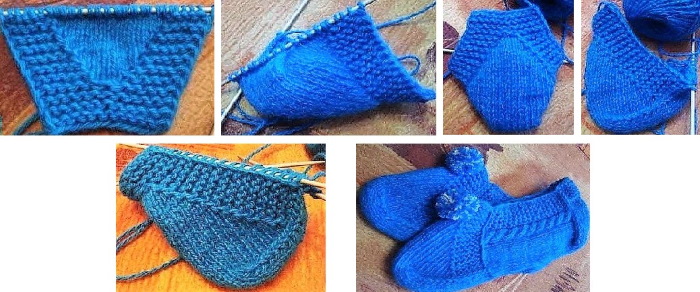

- The increase is done only on the front rows and concerns the loops before and after the garter stitch. The increase ends when there are 39 loops on the needles.
- The toe is rounded. For this, the central 9 loops are marked.
- 15 loops are knitted according to the pattern, 2 together, the work is turned.
- Next, 8 loops are knitted according to the pattern, the 9th and 10th are knitted together. As a result, only the central loops should remain.
- Next, 18 loops are cast on from both sides of the toe from the braids. The 45 loops obtained are distributed as follows: edge, 5 loops that will be knitted with garter stitch, purl, 4 front loops to form a cable, purl, 21 stocking stitch loops. Then in reverse order, starting with the purl.
- The harness is made through 3 rows: 2 loops are removed to a pin and left before work, the next 2 are knitted, then 2 loops from the pin. The pattern is observed from the wrong side. For size 36-37, you need to knit 40 rows.
- The heel is knitted according to the toe principle described above, by selecting 9 middle loops.
- The knitting ends with knitting with garter stitch, which you need to knit 8 rows. The loops are closed. The socks are decorated with bows, flowers or pompoms.
Knitted slippers by T. Brazhnikova
To knit these slippers you will need yarn of 2 colors (main and additional) and knitting needles:
- Cast on 68 stitches on the knitting needles, not too tightly, in one color.
- The first 2 rows are knitted in garter stitch using the main color.
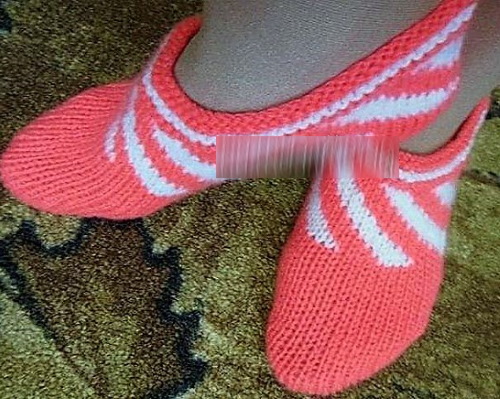
- Rows 3 and 4 are also garter stitch, but in an additional color.
- Row 5: after the first edge stitch, knit 3 loops, yarn over, 10 knit loops, yarn over, 10 knit loops, yarn over, 7 knit loops, yarn over, 6 knit loops, and then in reverse order. There should be 76 loops on the needles.
- Row 6 is knitted with face stitches, yarn overs are knitted using the twisting method.
- The next 4 rows are stocking stitch, then 12 rows are knitted in stocking stitch according to the pattern.
- The loops are divided into 3 parts (25-26-25) and only the middle part is knitted.
- After knitting the first part (25 loops), then the middle part (26 loops), the knitting is turned around.
- All 26 loops are knitted purlwise.
- In the next row, knit 24 stitches, and knit 25 and 26 together.
- 23 purl, 24 and 25 together purl.
- 22 knit, 23 and 24 together knit.
- 21 purl, 22 and 23 together purl. Decrease to 8 loops. Cut off the extra thread.
- Next row: 8 front loops, cast on 13 loops on the side and knit 25 loops of the side part. Knitting is turned.
- 25 purl stitches are knitted, the stitches picked up from the other side are knitted purlwise, and the remaining 25 are also purlwise. There are 76 stitches in the work again.
- All loops are again divided into 3 parts (37-10-37) and the sole is knitted on the middle ten loops.
Any option for knitting slippers with knitting needles, presented with diagrams and descriptions, has its pros and cons. On 2 knitting needles, you can knit a pair of slippers at the same time. The disadvantage of some methods is the need to sew the parts together.
Author: Cutie
Article formatting:Natalie Podolskaya
Video about knitting slippers
Knitted slippers with knitting needles - diagrams and description:

I knit with an elastic band, it looks beautiful and denser, and is comfortable on the leg.
I cast on 12 loops, knit 50 rows. I cast on 26 loops on both sides. I got 64 loops on the back. And then how to knit the socks on two knitting needles? I lost the description, please tell me
Cool knitted slippers. I want some for myself)